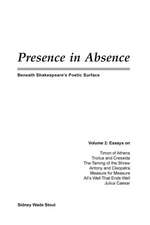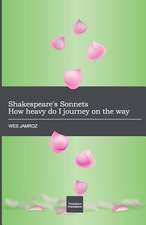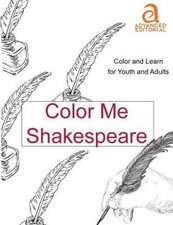Shakespeare’s Body Language: Shaming Gestures and Gender Politics on the Renaissance Stage
Autor Miranda Fay Thomasen Limba Engleză Hardback – 13 noi 2019
| Toate formatele și edițiile | Preț | Express |
|---|---|---|
| Paperback (1) | 215.96 lei 6-8 săpt. | |
| Bloomsbury Publishing – 19 mai 2021 | 215.96 lei 6-8 săpt. | |
| Hardback (1) | 566.35 lei 6-8 săpt. | |
| Bloomsbury Publishing – 13 noi 2019 | 566.35 lei 6-8 săpt. |
Preț: 566.35 lei
Preț vechi: 814.53 lei
-30% Nou
Puncte Express: 850
Preț estimativ în valută:
108.39€ • 112.74$ • 89.48£
108.39€ • 112.74$ • 89.48£
Carte tipărită la comandă
Livrare economică 12-26 aprilie
Preluare comenzi: 021 569.72.76
Specificații
ISBN-13: 9781350035478
ISBN-10: 1350035475
Pagini: 272
Ilustrații: 16 bw illus
Dimensiuni: 129 x 198 mm
Greutate: 0.36 kg
Editura: Bloomsbury Publishing
Colecția The Arden Shakespeare
Locul publicării:London, United Kingdom
ISBN-10: 1350035475
Pagini: 272
Ilustrații: 16 bw illus
Dimensiuni: 129 x 198 mm
Greutate: 0.36 kg
Editura: Bloomsbury Publishing
Colecția The Arden Shakespeare
Locul publicării:London, United Kingdom
Caracteristici
A
ground-breaking
new
study
of
Shakespearean
drama
and
the
role
of
gesture,
shame
and
humiliation
Notă biografică
Miranda
Fay
Thomasis
Assistant
Professor
in
Theatre
and
Performance
at
Trinity
College
Dublin.
Cuprins
Acknowledgements
Note
on
texts
List
of
illustrations
Introduction:
Embodying
shame
1.
Thumb-biting:
Performing
Toxic
Masculinity
inRomeo
and
Juliet2.
Figging:
Spanish
Anxieties
andAncientGrudges
in
Pistol'sHenriad3.
Spitting
at
Richard:
Taming
the
Beast
inRichard
III4.
Spitting
at
Shylock:
Shameful
Conversion
inThe
Merchant
of
Venice5.
Horning:
Fragile
Masculinity
inOthello6.
Hand-washing:
Female
Shame
inMacbeth7.
Kneeling:
Passive
Aggression
inCoriolanus8.
Stillness:
Female
Constancy
inThe
Winter's
TaleEpilogue
Bibliography
Index
Recenzii
In
eight
detailed
chapters
...
Thomas
offers
proliferating
possibilities
for
interpreting
key
scenes
and
speeches
-
a
fitting
strategy
for
a
work
on
fleeting
gestures
and
the
tricky
business
of
understanding
them.
What makesShakespeare's Body Languageremarkable ... is its deft consideration of a set of enduring and pressing concerns relating to the performance and policing of gender identity . Thomas achieves this by dextrously weaving in and out of recent performance accounts, rigorous cultural histories of specific gestures, and highly sensitive close readings, making the volume important reading material for students, scholars, and casual readers of Shakespeare's plays alike.
Through diligent historical research, contextual comparison, and contemporary reflection, Thomas has certainly created a body of research that will serve scholars, practitioners, and the generally curious.
Shakespeare's Body Languagebreaks new ground in its careful discussion of shaming gestures. Thomas weaves together scholarship on gesture and shame, gender studies, iconography and deft close readings of particular plays. It beautifully maps the rich terrain of non-verbal communication in Shakespeare.
Combining social and cultural history with an acute sense of theatre, Thomas reinvests familiar gestures - the thumb-biting inRomeo and Juliet,Lady Macbeth's hand-washing - with revelatory dramatic and emotional effects.
What makesShakespeare's Body Languageremarkable ... is its deft consideration of a set of enduring and pressing concerns relating to the performance and policing of gender identity . Thomas achieves this by dextrously weaving in and out of recent performance accounts, rigorous cultural histories of specific gestures, and highly sensitive close readings, making the volume important reading material for students, scholars, and casual readers of Shakespeare's plays alike.
Through diligent historical research, contextual comparison, and contemporary reflection, Thomas has certainly created a body of research that will serve scholars, practitioners, and the generally curious.
Shakespeare's Body Languagebreaks new ground in its careful discussion of shaming gestures. Thomas weaves together scholarship on gesture and shame, gender studies, iconography and deft close readings of particular plays. It beautifully maps the rich terrain of non-verbal communication in Shakespeare.
Combining social and cultural history with an acute sense of theatre, Thomas reinvests familiar gestures - the thumb-biting inRomeo and Juliet,Lady Macbeth's hand-washing - with revelatory dramatic and emotional effects.

























